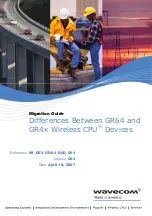
GR4x to GR64 Migration Guide
GPRS Multislot Class Support
Migration Guide
This document is the sole and exclusive property of WAVECOM. Not to be distributed or divulged without prior written agreement.
Ce document est la propriété exclusive de WAVECOM. Il ne peut être communiqué ou divulgué à des tiers sans son autorisation préalable
Product Capability
Multislot Downlink
Uplink
Active
Class
Slots
Slots
Slots
GR47
GR48
GR64
8 4 1 5 Yes Yes Yes
10 4 2 5 No No Yes
12 4 4 5 No No No
Multislot Class Performance – all configurations
Maximum Data Rate
Multislot Downlink
Uplink
Class
Slots
Slots
Receive
Send
32-40Kbps
8 4 1
8-12Kbps
32-48Kbps
8-12Kbps
4 1
10
24-36Kbps
16-24Kbps
3 2
32-48Kbps
8-12Kbps
4 1
24-36Kbps
16-24Kbps
3 2
12
16-24Kbps
24-36Kbps
2 3
8-12Kbps
32-48Kbps
1 4
Actual data rates achieved are dependent upon the Coding Scheme (CS) in use; the
table above shows the range of rates that are achievable within the CS classes
supported by the GR64.
The major impact of GPRS Class differences between the GR64 and legacy products is
the demand upon power supplies to maintain peak currents during the increased
number of transmission bursts within a single GSM timeslot. The major impact is in
the lower GSM bands (GSM850/900) where maximum transmitter output power is 2W
(33dBm). In order to support more than two bursts within a GSM timeframe it may be
necessary for integrators to review their power supply designs in order to make full
use of the added uplink slot capability of GR64.
To overcome the problem that multiple uplink allocation may present to legacy
applications, the following measure has been taken: users have the capability to
modify the GPRS operating class reported to the network in the initial release of
products, thereby avoiding the potential for being allocated additional uplink slots.
GR4x to GR64
Page 4 of 28
























